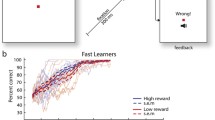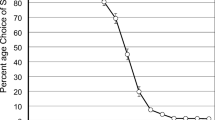Abstract
Male high school students worked a matching-to-sample task in the presence of 2 different stimuli. During one stimulus (S+) a correct match was positively reinforced by the production of a nickel. During the other stimulus (S−) a correct match was negatively reinforced by avoiding the loss of a nickel. The initial reaction was usually a transient superiority of accuracy in S+. This transient superiority could be reinstated by decreasing the time to work the problem or the time the sample stimulus was present. In addition, the rate of the observing response that produced the sample tended to be higher during S+, and the time that elapsed before beginning the observing response tended to be shorter during S+.
Similar content being viewed by others
References
APPEL, J. B. 1963. Aversive aspects of a schedule of positive reinforcement. Journal of the Experimental Analysis of Behavior., 6, 423–428.
AZRIN, N. H. 1960. Effects of punishment intensity during variable-interval reinforcement. Journal of the Experimental Analysis of Behavior., 3, 123–142.
AZRIN, N. H., & HAKE, D. F. 1969. Positive conditioned suppression: Conditioned suppression using positive reinforcers as the unconditioned stimuli. Journal of the Experimental Analysis of Behavior., 12, 167–173.
AZRIN, N. H., HAKE, D. F., HOLZ, W. C, & HUTCHINSON, R. R. 1965. Motivational aspects of escape from punishment. Journal of the Experimental Analysis of Behavior., 8, 31–44.
BAER, D. M. 1960. Escape and avoidance response of pre-school children to two schedules of reinforcement withdrawal. Journal of the Experimental Analysis of Behavior., 3, 155–159.
CATANIA, A. C. 1968. Contemporary research in operant behaviour. Glenview, Ill.: Scott, Foresman.
DINSMOOR, J. A. 1962. Variable-interval escape from stimuli accompanied by shocks. Journal of the Experimental Analysis of Behavior., 5, 41–47.
DINSMOOR, J. A. 1968. Escape from shock as a conditioning technique. In Jones, M. R. (Ed.), Miami symposium on the prediction of behavior 1967: Aver-sive stimulation. Coral Gables: University of Miami Press. Pp. 33–75.
ESTES, W. K., & SKINNER, B. F. 1941. Some quantitative properties of anxiety. Journal of Experimental Psychology., 29, 390–400.
FERSTER, C. B. 1967. Arbitrary and natural reinforcement. The Psychological Record., 17, 341–347.
FERSTER, C. B., & APPEL, J. B. 1961. Punishment of Sa responding in matching to sample by time out from positive reinforcement. Journal of the Experimental Analysis of Behavior., 4, 45–56.
HAKE, D. F., & AZRIN, N. H. 1965. Conditioned punishment. Journal of the Experimental Analysis of Behavior., 8, 279–293.
HAKE, D. F., & POWELL, J. 1970. Positive reinforcement and suppression from the same occurrence of the Ucs in a positive conditioned suppression procedure. Journal of the Experimental Analysis of Behavior., 14, 247–257.
HAKE, D. F., POWELL, J., & OLSEN, R. 1969. Conditioned suppression as a sensitive baseline for social facilitation. Journal of the Experimental Analysis of Behavior., 12, 807–816.
HOFFMAN, H. S. 1966. The analysis of discriminated avoidance. In W. K. Honig (Ed.), Operant behavior: Areas of research and application. New York: Appleton-Century-Crofts. Pp. 499–530.
HOLLAND, J., & SKINNER, B. F. 1961. Analysis of behaviour. New York: McGraw-Hill.
KAPLAN, M. 1956. The maintenance of escape behavior under fixed-ratio reinforcement. Journal of Comparative and Physiological Psychology., 49, 153–157.
LYON, D. O. 1963. Frequency of reinforcement as a parameter of conditioned suppression. Journal of the Experimental Analysis of Behavior., 6, 95–98.
SIDMAN, M. 1962. Reduction of shock frequency as reinforcement for avoidance behavior. Journal of the Experimental Analysis of Behavior., 5, 247–257.
SKINNER, B. F. 1953. Science and human behaviour. New York: Macmillan.
SOLOMON, R. L. 1964. Punishment. American Psychologist., 19, 239–253.
WEINER, H. 1962. Some effects of response cost upon human operant behavior. Journal of the Experimental Analysis of Behavior., 5, 201–208.
WEINER, H. 1964. Modification of escape responding in humans by increasing the magnitude of an aversive event. Journal of the Experimental Analysis of Behavior., 7, 277–279.
Author information
Authors and Affiliations
Additional information
This research was conducted at the Behavior Research Laboratory, Anna State Hospital, and supported by the Illinois Department of Mental Health, NIMH Grant 4926 and NIMH Grant 17981, and is based on part of a dissertation submitted by the senior author to Southern Illinois University in August, 1970, in partial fulfillment of the requirements for the Ph.D. degree.
Rights and permissions
About this article
Cite this article
Powell, J., Hake, D.F. Positive vs. Negative Reinforcement: A Direct Comparison of Effects on a Complex Human Response. Psychol Rec 21, 191–205 (1971). https://doi.org/10.1007/BF03394008
Published:
Issue Date:
DOI: https://doi.org/10.1007/BF03394008




